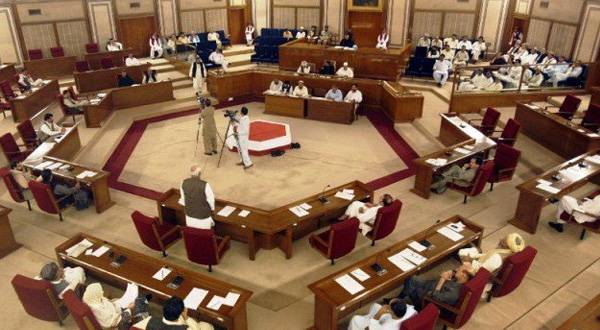The coalition government of Balochistan, which is led by Dr. Abdul Malik Baloch, unveiled Rs.244 billion deficit budget for financial year 2015-2016. As usual, the legislators of the provincial assembly, termed this financial year’s budget “friendly”, too. However, as compared to the previous year’s 215.713 billion budget, the government has increased its funds. On the other hand, independent economists say that this year’s budget, like that of the previous year, will be lapsed before getting reimbursed. Because, they further say, the law and order situation in the largest province of the country has not improved. So, it is seemingly impossible to revamp the provincial economy, which has been crumbling for decades.
While presenting the budget, the government of Balochistan said it would especially focus on the province’s energy sector. Therefore, in the budget, the highest allocation of Rs.14.3 billion, has been awarded to energy. Uninterestingly, while presenting the budget, electricity in the Balochistan Assembly went off. Despite the fact that the energy sector crisis has irked the people of Balochistan a lot, it is still not improving. Nor is the government attempting to end it. Therefore, on a daily basis, the people of Balochistan, particularly farmers, are facing problems due to load shedding. However, Khalid langove, the finance advisor to the Chief Minister Dr. Abdul Malik Baloch, announced that Rs.1 billion would be spent on providing solar energy to 300 villages, and Rs.157 on providing that to government buildings. But the question is: can this measure end Balochistan’s energy crisis?
One of the core issues of Balochistan is the situation of law and order, which has deteriorated. In the past few months, labourers were killed in Turbat, Hazaras were targeted in Quetta, and 22 Pashtuns were shot to death after their bus was intercepted in Mastung. These incidents were condemned nationwide. But, in spite of such events, the provincial government of Balochistan, instead of providing security to the masses, merely observed strikes with traders. Does this not show the helplessness of the provincial government of Balochistan? Also, in this year’s budget, like in those of the past, the government has allocated a huge sum for the improvement of the law and order situation – a 26 percent increase from the previous year. It means that Balochistan is going to be deprived of the major developmental works in volatile districts, as long as the dismal law and order situation continues.
Moreover, this year, too, the provincial government has increased allocations for the education and health sector to a greater extent. For education, they have allocated Rs.2.5 billion, which is a 17 percent increase from last year. The money, they said, would go into making 200 new schools, as well as for the upgrading of 456 primary and middle schools. Also, it was announced that as many as 1, 741 new employees, mostly teachers, will also recruited.
According to Article 25-A, education is the fundamental right of every child. But, ironically, it was recently reported by Alif Ailan – a non-profit organization working on education in the province – that 66 percent of Balochistan’s children do not go to school. So, what is the government of Balochistan doing to enroll them into schools? Schools and teachers are already present all over Balochistan, but schools are either closed or teachers do not go to take classes. So, what is needed is to take stern action against such teachers and to close schools that are not functioning.
No doubt, the health sector is ditched. It is also to be noted that Balochistan lacks independent, investigative journalists. Therefore, because villages are remote, their issues do not get reported. As a result, the people over there suffer silently. Despite this, in recent weeks, Ali Raza Rind, who is a journalist based in Chaghai, reported that children’s death ratio is 34 percent in Chaghai, let alone other 31 districts of the province. When contacted, local reporters of Balochistan’s remote areas say that hospitals in their areas bear a deserted look. There are neither doctors nor medicines available there. For getting themselves treated, they have to come all the way to Quetta, the provincial capital of Balochistan.
Coming to the agriculture sector, the provincial government has allocated Rs.12.1 billion to it. In the previous year, there was also a huge amount allocated to the agriculture sector, but it did not see improvements even though it plays a crucial role in the provincial economy. The government has not been paying proper attention to it, despite allocating funds. Due to frequent load shedding woes, people working in the agriculture sector are facing problems.
Anwar Sajdi, who is Editor-in-Chief of an Urdu daily in Quetta, told this scribe: “The financial year’s budget will be utilized in Balochistan’s Pashtun belt with ease, which is tranquil unlike Balochistan’s Baloch belt. As for the Baloch belt, the budget may not be properly utilized due to the bad law and order situation.”
Meanwhile, the opposition parties, particularly the Jamiat Ulema-e-Islam-Fazal-ur-Rehman faction (JUI-F), boycotted the budget presentation. They are sitting on opposition benches, and most of their ministers’ constituencies are in Balochistan’s Pashtun belt, who lament that their constituencies have been neglected in the budget.
Lastly, what is surprising is to know that the documents of the budget were not revealed to the media, clearly denoting a lack of commitment and transparency from the government’s side. This is one of the major reasons behind the harsh criticism that the government has to face at the hands of the opposition, as well as the media.






